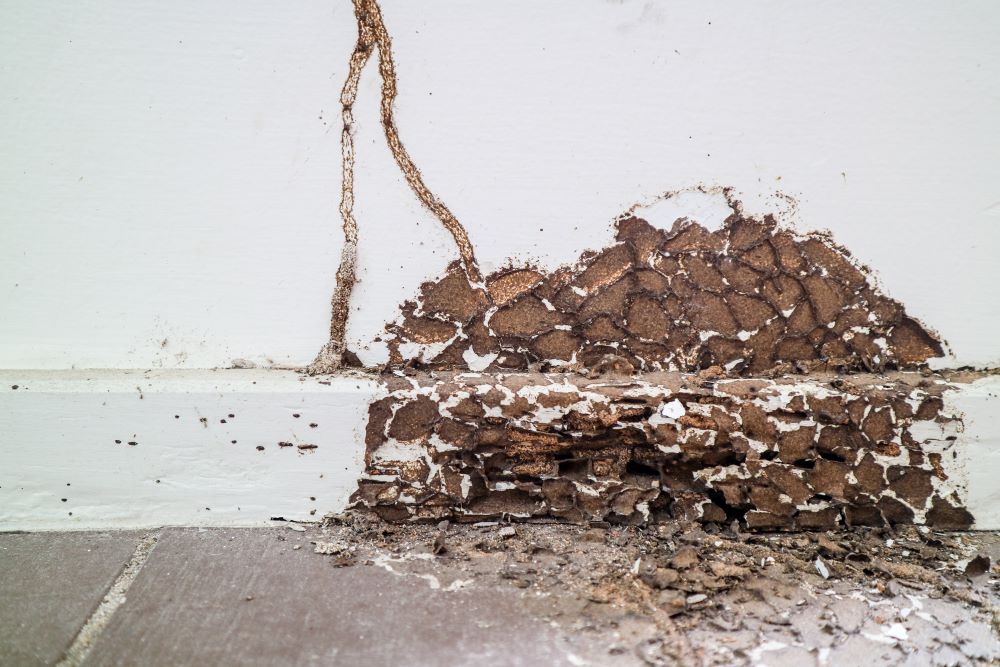Table of Contents
Carpenter ant droppings, commonly known as frass, are a telltale sign of these wood-boring insects lurking in your home. As moisture conditions attract these pests, spotting frass from carpenter ants can signal a hidden infestation requiring swift action.
Understanding what carpenter ant frass looks like and how to differentiate it from other pest remnants is crucial in protecting your wooden structures. This article aims to guide you through identifying and controlling carpenter ant infestations for a secure and pest-free home.
Identifying Carpenter Ant Droppings
Identifying carpenter ant droppings is a crucial step in detecting an infestation. These droppings, known as frass, are not just waste; they are a combination of various materials. Here’s what to look for:
- Composition: Frass from carpenter ants typically includes wood shavings, fecal matter, soil, gravel, and remnants of insects. The presence of these materials, especially near wooden structures, should raise suspicion.
- Appearance: Unlike the finer, grain-like droppings of termites, carpenter ant frass resembles sawdust and can vary in size, often appearing as small, dark, seed-like particles.
- Location: Check for frass around openings of nests, such as near walls, window frames, door frames, and roof lines. If you notice piles accumulating around baseboards, cabinets, or floors, it’s likely carpenter ants are tunneling within.
Remember, while termites consume wood, resulting in their frass looking like wood grains, carpenter ants discard waste that includes wood shavings from their nest-building activities, making their frass sawdust-like. If you suspect carpenter ant activity, it’s time to investigate further to protect your home from these wood-boring pests.
Signs of Carpenter Ant Infestation
As you become vigilant about the integrity of your home, it’s essential to recognize the subtler signs of carpenter ant infestation. These indicators can be the difference between early intervention and extensive damage:
- Unexpected Sightings: Finding large, black ants or their reddish-black counterparts inside your home, especially in large numbers, is a red flag. Witnessing winged ants, known as alates, emerging from crevices or walls, is particularly concerning as it suggests a mature colony is nearby.
- Frass: This fine sawdust-like material is the debris left behind from carpenter ants’ excavation activities. Spotting frass beneath wooden structures or along walls is a telltale sign of their presence.
- Unusual Sounds: Keep an ear out for soft crinkling or faint rustling noises emanating from walls or woodwork. These sounds indicate the ants are actively expanding their nests.
- Structural Oddities: Doors that stick or bulging walls can be symptoms of the structural changes caused by carpenter ant tunneling.
- Hollow Wood: Tapping on wood that sounds suspiciously hollow could mean that carpenter ants have carved out galleries within.
By staying alert to these signs of a carpenter ant infestation, you can take prompt action to mitigate the issue. If you notice any of these symptoms, particularly the presence of frass from carpenter ants or the distinctive rustling sounds, it’s time to call in the professionals. Addressing an infestation early can prevent further damage and restore your peace of mind.
Differences Between Carpenter Ant and Termite Droppings
Recognizing the differences between carpenter ant and termite droppings is essential for effective pest control. Here’s what sets them apart:
- Damage Patterns: Termites actually consume wood, creating long, damaging grooves that compromise structural integrity. In contrast, carpenter ants excavate wood to create nests, often in damp or decaying wood, but they do not eat it. Their tunneling may not weaken wood as significantly as termite damage, but it is still a cause for concern.
- Physical Characteristics: Termites and carpenter ants have distinct physical features. Termites have straight or slightly curved antennae and a broad waist, while carpenter ants boast a pinched waist and bent antennae, akin to handlebars. Coloration also varies; termites tend to be pale and slightly orange, whereas carpenter ants are typically black or reddish-black. Behaviorally, termites build mud tubes for structural access and live underground, unlike carpenter ants, which do not create mud tubes and are more commonly seen out in the open.
- Frass Appearance and Placement: Termite droppings, or frass, are small, pellet-shaped, and can be beige or black, resembling fine sawdust. You’ll find termite frass scattered around their nests and beneath damaged wood. On the other hand, frass from carpenter ants consists of wood shavings and looks more like sawdust, which accumulates near nest openings.
By keeping an eye out for these key differences, you can better assess the type of infestation and take appropriate action. Remember, if you encounter any frass carpenter ants leave behind or notice potential signs of damage, it’s time to seek professional assistance.
Effective Strategies for Controlling Carpenter Ant Infestations
To keep your home safe from the damage caused by carpenter ants, proactive measures are your best defense. Here are effective strategies for controlling carpenter ant infestations:
- Moisture Control: Since carpenter ants are attracted to damp wood, ensure your home is free from leaks and excess moisture. Regularly inspect for and repair any water damage to wood structures.
- Seal Entry Points: Caulk cracks and crevices around your foundation, windows, and doors to prevent ants from entering your home.
- Wood Maintenance: Keep firewood, lumber, and other wooden materials stored away from your home’s exterior to limit nesting opportunities.
For those facing an active infestation or wanting to ensure their home is protected, consider these steps:
- Professional Inspection: Schedule regular inspections with a pest control expert to detect signs of carpenter ant activity early on, which can save you from costly repairs down the line.
- Direct Treatment: If you’ve located a nest, applying insecticides, baits, or desiccants directly can be effective. For hard-to-reach areas, hiring a professional ensures the entire colony, including any satellite nests, is eradicated.
- Landscape Management: Maintain a clear boundary between your home and any vegetation. Trim back trees and shrubs, and remove rotting tree stumps and fallen branches to deter carpenter ants from setting up nearby.
Remember, dealing with carpenter ant droppings and the ants themselves can be challenging. If the infestation is extensive, or DIY methods have failed, reaching out to a professional pest control service is recommended to effectively remove and prevent re-infestation.
Conclusion
The discovery of carpenter ant frass within your home signifies more than just a pest presence; it warns of potential structural damage that requires immediate attention. Having explored the telltale signs, from the characteristic droppings to the subtle sounds of infestation, homeowners are now better equipped to detect and combat these wood-burrowing invaders. Recognizing the urgency of the situation is essential, as early intervention spares the integrity of your cherished abode.
With these insights into identifying and addressing carpenter ant activity, you have a solid foundation for safeguarding your home from unwelcome guests. Yet, when the situation calls for expert intervention, RECON Pest Services is here to help you keep your Omaha or Lincoln home free from pest problems year-round. Protect your home and gain peace of mind by taking the appropriate measures to tackle carpenter ant intrusions once and for all. Contact us today for a free quote!






